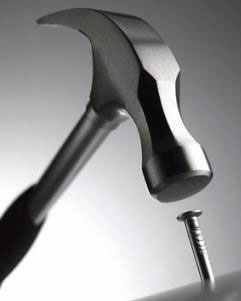In the byzantine world of tariffs and duties, the obvious is often at odds with the rules and regulations – a circumstance exacerbated by a trade war whose main munitions are tariffs and duties.
“A prominent psychologist once suggested that it must be tempting ‘if
US ITC Judge Gary S. Katzmann wrote in his opening remarks in the Opinion of OMG, Inc. vs U.S. and Mid Continent Steel & Wire, referring to a quote by prominent American psychologist Abraham Maslow.

What is a nail? There should be a commonsense answer, but in the world of tariffs and duties, it isn’t always clear what is and what is not a specific product - often with expensive repercussions for the party that comes out on the wrong side of a ruling.
The tariff war between the Trump Administration and China has resulted in tariffs on $250 million worth of Chinese products while China has countered with tariffs of $110 billion of U.S. goods – notably agricultural products. The G-20 meeting in Argentina between President Trump and Chinese President Xi Jinping yielded a 90-day truce, for the moment, putting on hold a U.S. 25% tariff hike, but the existing tariffs remain in place.
While weaponizing tariffs for national policy purposes is unusual, tariffs are a regularly used instrument of foreign trade – ostensibly to prevent “dumping” – the selling of products below cost into a country to the detriment of domestic producers.

In the U.S., the Smoot-Hawley Tariff Act of 1930 is the basis for U.S. tariff law, along with the Tariff Act of 1984, although tariffs and tariff legislation existed much earlier (Tariff Act of 1828). Smoot Hawley raised the tariffs on 20,000 imported products as part of protectionist action to protect domestic industries with the emerging Great Depression. Most modern economists feel that Smoot Hawley exacerbated an already bad situation and deepened and lengthened the historic economic plunge. Nonetheless, tariffs are a tool regularly deployed to protect domestic products by theoretically leveling the playing field through the addition of duty (or quota) or countervailing duty on a foreign import.
Tariff Nuts and Bolts
Unlike the tariffs currently being applied by the Trump Administration (Section 232 tariffs are authorized when U.S. national security is threatened), most begin with a complaint either by a U.S. company, union or the Department of Commerce (DOC) itself. The complaint is filed with the DOC and the International Trade Commission (ITC) which investigates the imports in question to determine the merits of the complaint. And should the complaint warrant it, the DOC determines applicable tariff or countervailing duty to be applied to the imported product.
Attorney David M. Murphy, who practices customs trade law with the firm Grunfeld, Desiderio, Lebowitz, Silverman & Klestadt (GDLSK) in New York City, explained in a telephone interview a nuts and bolts view of how a tariff comes into effect, “With a dumping case, a petition gets filed by the domestic interested party – that can be a union or company – whoever has interest in the imported merchandise, alleging the goods are less than fair value – dumped – or sold based on an export subsidy.”
Murphy continued, “And the Petition defines the “Scope” of the products covered by it (Petition) in terms of language of the “Scope” and are added to the HTS numbers.” HTS numbers are a US 10-digit import classification system and are administered by the US ITC.

Eventually, the Petition goes through a series of steps in a preliminary determination by the DOC, and assuming the DOC agrees with the petitioner that the product is being sold at less than fair value, the DOC sets an applicable tariff.
The process continues with investigation including input from foreign manufacturers until a Final Determination is made. As Murphy outlines this process, it eventually leads to the aptly named, “Final Determination which sets the dumping rate which becomes an anti-dumping Order. The Order sets forth the Scope of the products and goes forward and you [importers] have to deposit duties until there is what is called an Administrative Review when they finalize the duties and liquidate the entries.” Murphy added, “But in the process people[importers] look at the Scope and ask is my product covered by the scope of the order?”
Which brings us back to what is a nail?
Nailing Down a Nail
To a layman it might appear the entire anti-tariff procedure is tilted in favor of domestic interests – after all it is protectionist regulation. For example, the domestic interest can even look at its own “imports” and craft the complaint to exempt items that it imports from the complaint.
But the importer does have legal recourse. Murphy, who was among the lawyers representing the importer in the OMG case, explains that all of the parties are aware of “the language of the order and that the applicable “HTS numbers are there for reference only…. So, looking at the specific language, you’ve got to determine ‘does my product fall into the scope of this case?’”
In the case of OMG, Inc. vs U.S. and Mid Continent Steel & Wire, what was in question was whether “zinc anchors” imported from Vietnam should be included under the “Steel Nail” anti-trust Order.
The “zinc anchors” are used to attach items to concrete walls. Unlike a nail which is driven by a hammer to attach an item, the USITC Opinion noted, “OMG’s anchors are “inserted into predrilled holes ½ inch deeper than the Zinc Anchor embedment… A hammer is then used to strike the steel pin, which expands the zinc body into firm contact with the materials to be fastened.”
Back in 2014, Mid Continent Steel & Wire (“Mid Continent”) petitioned DOC to impose antidumping and countervailing duties on steel nails from China and a number of countries, including Vietnam. In July 2015, after having determined that dumping was occurring, the DOC issued the antidumping and countervailing duty Orders covering certain steel nails from Vietnam. The “scope” of the ruling included the critical statement:
“Certain steel nails may consist of a one-piece construction or be constructed of two or more pieces. Certain steel nails may be produced from any type of steel, and may have any type of surface finish, head type, shank, point type and shaft diameter. Finishes include, but are not limited to, coating in vinyl, zinc (galvanized, including but not limited to electroplating or hot dipping one or more times), phosphate, cement, and paint.”
OMG filed a request with DOC on August 5, 2016, for a scope ruling that its zinc anchors should be excluded from the scope of the Orders. OMG argued its anchors were not nails and thus did not fall within the DOC’s scope of orders and that “Commerce’s analysis and scope determination is unsupported by substantial evidence on the record and is otherwise not in accordance with law.”
However, on February 6, 2017, the DOC issued its Final Scope Ruling, in which it determined that OMG’s zinc anchors were “unambiguously within the scope of the Orders based upon the “plain meaning of the Orders.”
Following the DOC decision, on June 29, 2017, OMG then filed a complaint with the USITC contesting the Final Scope Ruling naming the U.S. Government as the defendant and Mid Continent Steel & Wire, defendant-intervenor.
So, What is a Nail?
On May 29th 2018, US ITC Judge Gary S. Katzmann in his Opinion of OMG, Inc. vs U.S. and Mid Continent Steel & Wire, began his remarks with the following comment; “A prominent psychologist [Abraham Maslow] once suggested that it must be tempting ‘if the only tool you have is a hammer to treat everything as if it were a nail.’” Wryly adding that OMG believes the DOC “made such an error.”
Judge Katzmann, besides taking into account the parameters of the legal arguments of the question of “what is a nail”, noted the Court “in determining the common meaning of a term, courts may and do consult dictionaries, scientific authorities, and other reliable sources of information, including testimony of record.” In layman’s’ terms, does the product fit the colloquial description and usage of a “nail”?
In the end the Court concluded that “the product at issue is not a nail within the plain meaning of the word “nail” and is, therefore, outside the scope of the Orders.”
While the Court’s decision was a win for commonsense, the case illustrates the complexity of the Customs’ regulatory regime. And it is worth pondering if this much time and money went into defining a nail, what happens as the number of disputed products exponentially grows? Do we have the tools to handle it?





